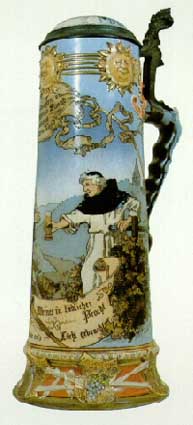
 |
The Mettlach dinnerware portion of the factory still exists today, although because of production changes it now occupies a smaller area. In 1869 the first facility for tile production was set up and from about 1905 we hear mention of the former Dresden plant where ceramics used in the field of sanitation were made. With the establishment of a crystal plant in Wadgassen, Saar in 1843 the production of dinnerware became less and less important at Mettlach while the production of ceramic materials used in the building trades came to the fore.
Then, in the 1880s, the production of stoneware products was begun, or rather reinstated, since they were already in production since circa 1843. However these early examples, with their simple lines and rather colorless decoration marked by sporadic platinum painted highlights, had never enjoyed the fame nor been representative of the splendor and technical perfection of the stoneware articles which marked the period from 1885 to 1905. It is this period which we would like to treat here in a more detailed manner. The Mettlach plant took part in the World’s Fair Exhibitions in Philadelphia in 1876 and Paris in 1878. The production of steins, punch bowls and wall plaques must have been begun a few years later. I am convinced that the historian, architect and archaeologist, August von Cohausen played a very important role in this development and through his friendship with the plant management was able to persuade it to systematically shift the production over to stoneware. In his report on the Paris Exhibition of 1878 he describes in great detail the stoneware products of Doulton, England and those of Höhr-Grenzhauzen/Westerwald, Germany, however he describes only the tiles and decorative architectural materials produced at Mettlach. He then goes on to describe the technology, colors, forms and decoration which should be utilized at the Mettlach plant: “It is not necessary to slavishly imitate the antique, but that which one produces should be composed in the spirit of the Renaissance, at which time those steins were a luxury article and one must imitate those production methods.”
This statement is decisive for the development of the new production facility at Mettlach in the 1880s; the friendship between Cohausen and Eigen von Boch had already existed for many years. In 1840 this highly intelligent and very cultivated man was invited to take a position at the Mettlach plant as Vice-Director. He accepted a short time later and advised Eigen von Boch in the founding of the mosaic production facility as well as in the restoration of the old abbey tower. In 1885 the first stoneware catalog was issued at Mettlach and in this same year Villeroy & Boch took part in the World’s Fair in Antwerp, displaying a collection from this new production branch.
A report covering this display states the following: “If the Mettlach factory has achieved perfection in these products (referring at first to dinnerware and washbowl sets), then it is preeminent in the area of its specialization, namely the production of fine stoneware. This material differs from the usual stoneware of the lower Rein or Bavaria in that it consists of fusible minerals which take on and impart beautiful coloration to the entire mass of material. From this splendid material, which is absolutely compact and impermeable and which affords the fullest decorative scope, are formed splendid beer steins, bumpers, drinking cups, beverage sets, hanging baskets, vases and fancy bowls to which have been imparted a refined and truly artistic relief ornamentation. For all of the pieces here exhibited bear the modern, yet dignified style which marks this firm’s production. The colored decorations are partly composed of colored clay of which the main object has been formed and partly of multi-colored, molded relief decorations. Sometimes they are decorated with either serious or gay figures or scenes and are again painted with tinted ceramic pastes or so-called hard glazes.” This text shows how highly thought of these articles were right from the start and how favorably the buying public must have reacted.
|
A second catalog was issued in September of 1890 and a third in December of 1894. A new edition was brought out in 1899 followed by three supplements; one appeared in November of 1901, a second between 1901 and 1905 and a third in August of 1905. This span of twenty years may be viewed as the golden period of Mettlach stoneware, although production continued until circa 1913, and in these later years some very beautiful objects were produced. In the period between 1925 and 1929 production was begun again for a short time, mainly because of several sizeable orders; however two factors dictated the final end of stoneware production: firstly the high cost of the articles and secondly the lack of qualified skilled workers.
The interest in these stoneware articles during the period between 1885 and 1905 must have been very high, since sales overseas and to England can now be attested to: Countless steins, punch bowls and wall plaques can still be found in the hands of collectors or as they appear from time to time in auction sales. In the U.S., for example, the interest has been so great that several catalogs and price lists of Mettlach products have been printed and in 1965 the Stein Collectors International was founded. This club, with members around the world, publishes a quarterly devoted to stein collecting bearing the name Der Gemutlichkeit from 1965 to 1969, and from that year to the present the name Prosit. Of special interest to many members of this club are those steins produced at Mettlach. The products of this splendid era, long neglected, are now finding a place in history, so to speak. This interest is also on the increase in Europe, and it is with the idea of filling the growing need for information around the world that this present volume of catalog facsimiles has been prepared.
There are two types of Mettlach stoneware, although these types arise not through the composition of the material, but instead according to the way in which it is worked. In both cases we are dealing with a hard, compact, homogeneous and vitrified product which is usually coated with a matte glaze.
In the first type we have the so-called “Chromolith.” In this case, just as the meaning of the word points out, the mass, or basic clay consists of at least two colors, but often more, which are worked along side one another while still being sharply separated from one another. Certain portions of the decoration may be slightly raised. In most cases the variously colored sections are separated by means of an intaglio line which is colored black, thus giving the individual areas and figures a distinct emphasis. (See Figure 1) The combination of colors is in no way lacking in harmony.
Although neither the company archives at Mettlach nor the factory can provide any records (a great fire during the night of August 11-12, 1921 destroyed the pattern and mold storehouse), we know that a multitude of colors was used: 150 under glaze as well as 30 colored clay slips and 176 different glazes. An original master drawing for a beer stein with chromolith decoration and black separation lines, dated 1897 and signed Fritz Quidenus (from the collection of A. Post, Saarwellingen, Germany — Figure 2) shows that each color tone had its own number and that the scale of colors carried very subtle variations.
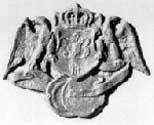 |
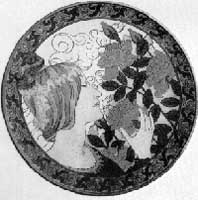 |
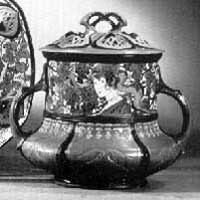 |
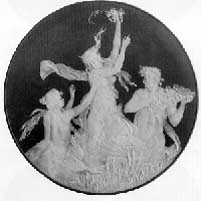 |
There is, however, a variant of this phanolith technique which might be categorized as cameo stoneware. Here too, the slightly raised, ivory-colored decorations are set upon a light-blue or light-green background; in this case the green is somewhat yellowish. The two main differences between this cameo-stoneware and true phanolith lie in the manner in which the decoration is applied and the numbering system used.
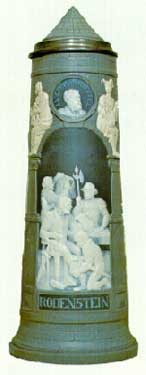 |
1. Gesetzlich gaskets – This means: copyrighted. Can be mentioned in English for the export trade.
2. Musterschutz – This means model or decoration is protected against copying by a patent.
3. Reg. U.S. Patent (office) – This stamp was introduced as export to the U.S. became more important.
4. Made in Germany – This was also intended for the export trade.
5. % – This symbol is found in color, under glaze. It probably designates that the article bears some factory defect.
It might be mentioned that on some early pieces, the rectangular banner bearing the word Mettlach is slightly raised.
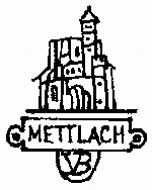 |
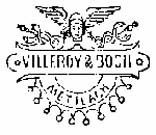 |
The great precision with which the chromolith and phanolith articles were produced points to the highly skilled craftsmen who designed and decorated the stoneware. Although factory records are very fragmentary, the following listing may be helpful. The artists who produced the best models were (in alphabetical order):
Buch, R. Stein No. 1530 as well as Stein No. 1560 have been attributed to him.
Chevroton, L. Some pieces bear the initials L. Ch. Among those articles attributed to him are Plaque Nos. 2560 and 2561, 2550. 2551, 2592, 2593 and Vase No. 2589.
Dorner, Emil. Among the articles attributed to him is Stein No. 280.
F. Although it has not been established to whom this initial refers, it appears on Punch Bowl No. 3037.
Founder, R. Designed Plaque Nos. 2544 and 2545. Not much is known about him, but he probably came from France, where a famous artist family with this name is listed.
Fuchs. Stein No. 2210 bears his name.
Gorin, C. Stein No. 1818 bears his name.
H. This initial is found on Vase No. 2414 and Jardiniere No. 2417.
H.D. These initials are found on Stein 2005.
Hein, M. Many articles were designed by him; among them are: Plaque Nos. 2507 and 2508, 1418, 1676; the large Pouring Pitcher No. 1568; Stein Nos. 1823, 1987, 1997, 2076 and 2869.
Hohlwein, Ludwig. A stoneware decorator, probably born in Wiesbaden in 1874. He designed Stein No.3281 which is dedicated to various sports. Hohlwein died in Berchtesgaden in 1949.
Mangum. Rectangular Plaque No. 2546 is attributed to him.
M.C. These initials are found on Stein No. 2833B.
Olbrich, J.M. Was born in Troppan, Moravia in 1867 and died in Dusseldorf in 1908. He was active in Darmstadt from 1899 and was deeply involved in the art nouveau movement. As far as I know, he did not sign articles designed for Mettlach, yet, judging from the style of the pieces, one might attribute the following to him: Vase No. 2915; Tea Service Nos. 2946, 2947, 2948 and 2960.
Payen, L. Plaque No. 2590, 2591, 2596 and 2597.
Quidenus, Fritz. Was mainly active in stoneware decoration at Mettlach. Among the many pieces which he designed are the following: Stein Nos. 2441, 2501, 2531, 2581, 2582, 2880, 2937, 3143, 3144 and 3221; Plaque Nos. 2287 and 2288.
Reiss, Fritz. Was born in Dusseldorf in 1857 and died in Freiburg in Breisgau in 1916. He signed a plaque with a Black Forest theme. (Listed in Peretz Auction, Saarbrucken, 42 and 43, March 1975, No. 644/6).
Schlitt, Heinrich. Born in Biebrich-Mosbach in 1849, he was the most prolific stoneware designer at Mettlach. There are a great many items bearing his monogram or complete signature; among them: Stein Nos. 1809, 1909, 1909/727, 1909/1038, 1909/1110, 2089, 2090, 2100, 2107, 2122, 2123, 2176/954, 2177/959, 2177/960, 2178, 2180/955, 2181/958, 2191, 2261/1012, 2262/1054, 2271/955, 2271/994, 2368/1109, 2382, 2419/1041, 2520, 2524, 2580, 2764, 2765, 2777 and 2778. Plaque Nos. 2112, 2113, 2148, 2149, 2199, 2200, 2694, 2697, 2698, 2769, 2088 and 2513.
Seebock, Professor. Born in 1864 in Vienna. He was active in Rome and, according to the 1905 price list, designed the phanolith Plaque No. 7056 (25.5 x 35 cm). This plaque cost 50 Marks at that time, or almost twice as much as the Stahl phanoliths.
Schultz, W. (Initials also appeared as W.S., W.S.H., or W.Sch.). One of the better designers, who, along with Warth and Schlitt, produced plaques and steins that are masterpieces of ceramic art. A few of these pieces are: Stein Nos. 1817, 1851 and 2126 (signed W. Schultz, Hanau). Plaque Nos. 1384, 1385, 1769 and 1770 (signed and dated W. Sch. 87).
Stahl, Johann Baptist. Has been mentioned as active at Mettlach during the period 1895 to 1920. He was born in Oberbetschdorf/Alsace and died in Mettlach in 1932, 72 years old. His name is tied together with the phanolith/cameo stoneware production and he is designated as a modeler in company records. His works usually bear the signature J. Stahl or the initials JS intertwined. Among the pieces attributed to him are: Stein Nos. 2530 and 2607. Vase Nos. 2446 (signed and dated J. Stahl 97) and 2447. Plaque Nos. 2442, 2443, 3112, 3113, 5230, 5231, 7025, 7026, 7030, 7031, 7040, 7041, 7042, 7044, 7045, 7046, 7047, 7084 and 7085.
Stöcke. Several plaques are attributed to him, including Nos. 2041, 2042, 2071, 2072, 2078, 2079, 2080, 2081, 2142 and 2143.
Stuck, Franz von. Was born in Tettenweis near Passau in 1863 and died in Munich in 1928. At least two steins are attributed to him. namely, Nos. 2007 and 2009.
Thevenin. Plaque Nos. 2542 and 2547 are attributed to him.
Warth, Christian. Came from the town of Birkenfeld and was employed as a designer at the faience factory. There he produced copper engravings as well as stoneware models. He was active in Mettlach from 1854 to 1892, and many of his works are known. Among them are the following: Stein Nos. 1161 (a seven liter stein which was the most expensive which Mettlach ever produced), 1163, 1396, 1403, 1494, 1524, 1527, 1536, 1632, 1641, 1644, 1645, 1690, 1721, 1723, 1734, 1742, 1759, 1795, 1796, 1915 and 1932. Plaque Nos. 1487, 1488, 1607, 1651 and 1652.
Winterwerber, E. The designer of an oval Flower Bowl No. 2646 and most likely also the designer of Stein No. 2028 which bears the initials E.W.
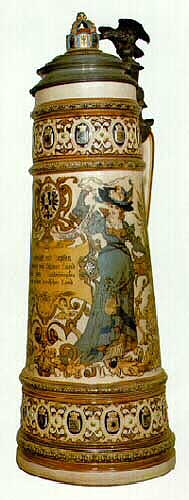 |
One also notices that the steins were available with insert lids or all pewter lids. A lid made of all pewter was more expensive than a lid with a ceramic insert. The Mettlach factory was closely connected with a pewter foundry which was located in the vicinity of the Mettlach train station; it was still active until the beginning of the 1920s and was last managed by Reinhold Engel.
I would not like to infer that the material presented here is to be considered as a final word on Mettlach stoneware production. There is much more to be done in the area of artists involved, for example. In addition, the supplement II of the 1899 stoneware catalog must be located and more of the stoneware and Delft Faience. Around 1890, most surely under the influence of La Louvière’s (Boch FRERES factory) successful use of decorative techniques based on the Delft style, the artists at Mettlach also began to produce plates, vases and ornamental vases which were decorated in a style reminiscent of the Delft ware of Holland or the faience of Rouen. We cannot tell exactly when production was begun, but we do know that many pieces of this type were exhibited by Villeroy & Boch at the World’s Fair in Chicago in 1893. This at least provides us with the latest period that they might have been brought out. Thanks to the elegant and rich decoration of these pieces, many of them found their way into castles and important collections. In July 1965 the Saarbrücker Landeszeitung featured a report on the area between the Teutoburgerwald and Weserbergland called Cheruskerland which included a description of the Renaissance-style castle belonging to the Princes of Lippe. Pictured in this article was a vase mounted on a pedestal with a combined height of 2.35 meters. In the booklet Kleiner Führer durch das Schloß Detmold (Brief Guide through the Detmold Castle) we find mentioned: “The large ceramic vase comes from the firm of Villeroi and Boch in Mettlach.” This same vase was exhibited in Chicago in 1893.
The decorations were either hand painted, partially hand painted or printed. In almost all cases these items produced in later years must be researched. However, this present volume, as it now stands, can be revised and expanded. Those of us connected with the Mettlach Archives at Villeroy & Boch will welcome all information which will help fill voids and will do as much as we can to solve problems and answer questions which arise after the publication of this book.
Before concluding, I would like to devote a few words to the description of some of the articles shown in these catalogs which have not been covered above. As the catalog title indicates, I am referring here to those items described as Old Frankish delft imitations bore a blue mark consisting of the initials VBM, with or without the word Delft. This type of article, which has too long been neglected, remained in production until the 1920s; sometime between 1925 and 1927 production was halted.
Nikolaus Lessel was one of several artists who were closely connected with this type of ceramic ware. He was born in Mettlach/Keuchingen in the year 1881 and at the age of 14 came to work at the faience factory of Villeroy & Boch. It was there that he attended the art school from 1895 to 1898. Upon graduating first in his class, he was employed as an earthenware painter. His specialty was the blue-white Delft painting featuring the well-known Dutch motifs.
In conclusion, it is our hope that the compilation of material on Mettlach products contained in this volume will be a contribution welcome by collectors and students of ceramics everywhere. We hope too, that it will demonstrate that these items are an expression of the popularity of styles incorporating elements of neo-Gothic and Renaissance, art nouveau and old Germanic culture. The fact that these items are collected and imitated, and eagerly sought after by Western Europe, the U.S., and more recently Japan, attests to the fact that these are quality products which accurately reflect the civilization, the thought, and cultural milieu of the period in which they were created.
| Dr. Thérèse Thomas, Director Villeroy & Boch Archives and Museum Translated by Albert A. Hoch |
Cohausen, A. von, “Einige technische Bemerkungen uber die gröberen Thonwaaren auf der Pariser Ausstellung 1878,” Mittheilungen des Gewerbevereins für Nassau, 1879.
Hansen, H.J. Das pompöse Zeitalter zwischen Biedermeier und Jugendstil, Gerhard Stallung Verlag Oldenburg, 1970.
Hirschfeld, P., “Die Firma Villeroy & Boch auf der 1885er Weltausstellung von Antwerpen,” Export, Organ des Central-Vereins für Handelsgeographie etc., Berlin, 1885.
Honeker, H., “Mettlacher Steins in den USA,” Keramos, Werkzeitschrift V&B, 6, 1965, pp. 18-19.
Lowenstein, Jack G., A Stein Bibliography, Princeton, N.J., 1974.
Lowenstein, Jack G. & Pat Clarke, English Translation 1899 Mettlach Catalogue with Supplement Steins, Princeton, N.J., 1974.
Mohr, R.H., Mettlach Steins and their prices including Plaques, Beakers, Punch Bowls, 5th Edition, Rochford, Illinois, 1974.
Von Ortzen, P., “Eine interessante Begegnung (Commes, Speicher),” Keramos, Werkzeitschrift V&B, 4, 1965, pp. 9-10.
Ratius, G., “Die ‘Mettlach Steins’ haben es ihnen angetan,” Keramos, Werkzeitschrift V&B, 4, 1969, pp. 16-18.
Thomas, Th., “Die Rolle der beiden Familien Boch & Villeroy im 18. und 19. Jahrhundert,” Die Entstehung des Unternehmens Villeroy& Boch, Saarbrucken 1974.
“Die Ziegel und Thoonwaaren Industrie in den Vereinigten Staaten und auf der Colombus Weltausstellung in Chicago,” Deutsche Töpfer- und Ziegler-Zeitung, 17 Nov. 1893, No. 46; 19 Jan. 1894, No. 3; Beilage 12 Jan. 1894, No. 2.
Keramos, Werkzeitschrift Villeroy & Boch, 1952.
Der Gemuetlichkeit, September 1965 (No. 1) through June 1969 (No. 16).
Prosit, Sept. 1969 (No. 17) through June 1975 (No. 40).
Antique Steins at the Paine Art Center, Oshkosh, 10 May 29 June 1969.
Aspekte der Grunderzeit, Akademie der Kunste Berlin 1974, Munchner Stadtmuseum und Frankfurter Kunstverein 1975.
__________
*Reprinted by permission from Mettlacher Steinzeug: 1885 – 1905, Hans J. Ammelounx, Wheeling, IL, 1975